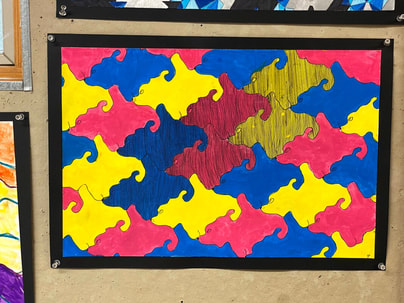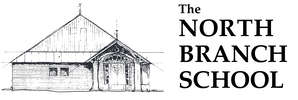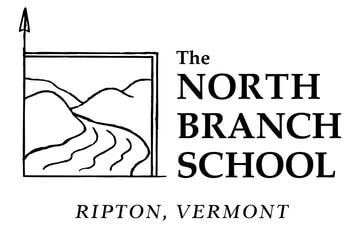Mathematics
During the three years at North Branch students will explore topics in algebra, geometry, trigonometry, statistics, mathematical computation and problem solving. Topics of study include: exploring and communicating mathematically; simplifying expressions and solving equations; problem solving; coordinates and functions; two and three dimensional geometry; proportional reasoning and similarity; properties of linear functions; and representing data and finding measures of central tendency; transformational geometry; models of change; linear systems; quadratic functions and graphs; coordinate geometry and quadrilaterals; probability and counting strategies; angles and special angle relationships, triangles and right triangle trigonometry; and circles. Whenever possible, I will connect these topics to real life applications.
Instructional Methods
In general, math will be taught in a two-day cycle. Activities on day one of the cycle include: self-correcting the previous day’s practice set and actively participating during the presentation of the new lesson. The homework will usually be a mini-problem set and making revisions to the previous problem set, if necessary. Activities on day two include: correcting the mini-problem set, and beginning the practice set that corresponds to the lesson from the previous day. The homework will be to finish the practice set. The two-day cycle will be modified as needed to provide time for more complex investigations, explorations, use of technology, projects, enrichment activities, test reviews, and extended problem solving activities.
Assignments
As stated above, there are two types of assignments - practice sets and mini-problem sets (MPS). While each of these types of assignments is designed to help students achieve mastery of the material, they all have a different focus. The practice set provides the first opportunity to work on new skills. Therefore, it is designed to begin as an “in-class” assignment, and, in most cases, end as a homework assignment that should be completed by the beginning of the next class. Students are encouraged to work collaboratively in class and at home on these problem sets. They are not assessed on the basis of number correct, but rather on timeliness, completeness of work, and thoroughness of revisions, if any are needed. Students will be asked to “stop light” the learning intentions on each practice as a way of communicating their confidence level with the material (Green - I’ve got this; Yellow - A bit murky, maybe I need more practice; Red - I must have missed something important). If there are a lot of students indicating yellow or red for a particular learning intention, it will signal me that I need to re-teach and/or provide more practice opportunities. If an individual student is indicating yellow or red for a particular learning intention, it should signal them that they may need to make arrangements to stay after school for extra help.
The mini-problem sets provide another type of practice – review of skills from earlier in the unit, course, or even previous math courses. The purpose of these assignments is to make sure the skills learned at the beginning of a unit stay sharp. There is nothing worse than getting to a test at the end of the unit get asked to do problems that haven’t been practiced in 3 weeks. In general, the homework on any given night will alternate between completing a practice set that was started in class and doing an MPS, depending on where we are in the two day lesson cycle. Sometimes homework will also include some basic skill work, or, as we approach the end of a unit, a larger review assignment. Optional bonus assignments are also sometimes offered.
Assessments
There will be a quiz at the half-way point of most units. The quiz is a “snapshot” to let students, parents, and me, know where students are in their understanding of the concepts presented thus far in the unit. Unit tests are the culminating assessment for most units. We will have worked hard throughout each unit to make sure that you are well prepared for each test. Tests are not designed to surprise or trick you in any way. If you have worked consistently throughout the unit and made use of the available supports along the way, you should do well on these assessments. In addition, the class(es) before a test will always include a review session with a review assignment to complete for homework.
In general, math will be taught in a two-day cycle. Activities on day one of the cycle include: self-correcting the previous day’s practice set and actively participating during the presentation of the new lesson. The homework will usually be a mini-problem set and making revisions to the previous problem set, if necessary. Activities on day two include: correcting the mini-problem set, and beginning the practice set that corresponds to the lesson from the previous day. The homework will be to finish the practice set. The two-day cycle will be modified as needed to provide time for more complex investigations, explorations, use of technology, projects, enrichment activities, test reviews, and extended problem solving activities.
Assignments
As stated above, there are two types of assignments - practice sets and mini-problem sets (MPS). While each of these types of assignments is designed to help students achieve mastery of the material, they all have a different focus. The practice set provides the first opportunity to work on new skills. Therefore, it is designed to begin as an “in-class” assignment, and, in most cases, end as a homework assignment that should be completed by the beginning of the next class. Students are encouraged to work collaboratively in class and at home on these problem sets. They are not assessed on the basis of number correct, but rather on timeliness, completeness of work, and thoroughness of revisions, if any are needed. Students will be asked to “stop light” the learning intentions on each practice as a way of communicating their confidence level with the material (Green - I’ve got this; Yellow - A bit murky, maybe I need more practice; Red - I must have missed something important). If there are a lot of students indicating yellow or red for a particular learning intention, it will signal me that I need to re-teach and/or provide more practice opportunities. If an individual student is indicating yellow or red for a particular learning intention, it should signal them that they may need to make arrangements to stay after school for extra help.
The mini-problem sets provide another type of practice – review of skills from earlier in the unit, course, or even previous math courses. The purpose of these assignments is to make sure the skills learned at the beginning of a unit stay sharp. There is nothing worse than getting to a test at the end of the unit get asked to do problems that haven’t been practiced in 3 weeks. In general, the homework on any given night will alternate between completing a practice set that was started in class and doing an MPS, depending on where we are in the two day lesson cycle. Sometimes homework will also include some basic skill work, or, as we approach the end of a unit, a larger review assignment. Optional bonus assignments are also sometimes offered.
Assessments
There will be a quiz at the half-way point of most units. The quiz is a “snapshot” to let students, parents, and me, know where students are in their understanding of the concepts presented thus far in the unit. Unit tests are the culminating assessment for most units. We will have worked hard throughout each unit to make sure that you are well prepared for each test. Tests are not designed to surprise or trick you in any way. If you have worked consistently throughout the unit and made use of the available supports along the way, you should do well on these assessments. In addition, the class(es) before a test will always include a review session with a review assignment to complete for homework.

Below is a tentative list of units/topics and the essential questions that will guide the content of each unit.
At this point they are not in order and are not organized by grade level.
Our Number System
Properties of Quadrilaterals
At this point they are not in order and are not organized by grade level.
Our Number System
- How/why does it work?
- How do we use algebraic tools and conventions to simplify an expression?
- How do we use algebraic tools and conventions solve an equation or inequality?
- What operations and properties can be used while still maintaining equality?
- What is a function?
- How do people describe and represent them?
- What’s the question?
- What are the mathematical tools for problem solving?
- How do I share my work and my results?
- How can we quantify the size of a 2D or 3D figure?
- How are comparisons useful?
- What are the ways we reason proportionally to solve problems?
- How are exponents related to basic arithmetic operations?
- How can exponential notation be used as a shortcut to solve problems and represent values?
- What are common ways to display data and identify trends?
- How can we interpret them?
- How can you transform a shape?
- How do transformations change a shape?
- How can you solve a system of equations?
- How can you determine the best method for you to solve a system of equations?
- How can a pair of angles be related?
- How can you use the properties of special angle pairs to solve problems?
- How are right triangles special?
- How can you use the properties of special triangles to solve problems?
Properties of Quadrilaterals
- How are quadrilaterals classified/related?
- How do you factor quadratic expressions?
- How can quadratic functions be represented?
- What methods can you use to solve a quadratic equation?
- How are the properties of circles, polygons, and polyhedra alike and/or different?
- How can shapes and figures be described?
- How many different outcomes are possible?
- How likely is an outcome?
- What do we need to do to prove something


